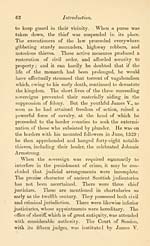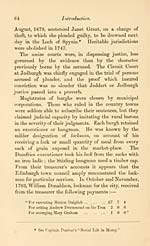Grampian Club > Scotland, social and domestic
(69) Page 63
Download files
Complete book:
Individual page:
Thumbnail gallery: Grid view | List view

Introduction. 63
in May, 1532, for the cognizance of those offences,
and of civil causes, which had formerly been determined
by the King and Council, or a Committee of the
Estates.
The greater number of civil and criminal causes
were decided by the feudal barons and lords of regality.
The barons exercised a powerful jurisdiction ; their
courts consisted of a seneschal, a chamberlain, a demp-
ster or doomster, and other officials ; they adjudicated
in momentous civil causes, and in criminal cases passed
and executed sentence of death. As a rule, every land-
owner was a lord of regality, and possessed jurisdiction
over the property and persons of those who resided on
his estate. Originally the feudal courts were styled
justice-aires, and were held on the high places ; many
hills are still known in the lowlands as " laws." Sub-
sequently the barons constructed justice-rooms in their
castles and manors. The hall of justice at Doune Castle
is tolerably entire.
The barons were exempted from personally attending
to their judicial duties. They appointed deputies or
bailies, who presided in their absence, and always
occupied the judicial bench in outlying districts.
The punishment of felony was death. Sentence was
pronounced by the doomster, and execution speedily
followed. Latterly the doomster discharged the twofold
office of pronouncing sentence and executing it.
Capital sentences pronounced in baronial and regality
courts were carried out by two methods. The lowland
convicts were hanged ; in highland districts condemned
females were allowed the alternative of perishing in the
water. The Baron Court of Sir Eobert Gordon of
Gordonston, held at Drainie, Morayshire, on the 25th
in May, 1532, for the cognizance of those offences,
and of civil causes, which had formerly been determined
by the King and Council, or a Committee of the
Estates.
The greater number of civil and criminal causes
were decided by the feudal barons and lords of regality.
The barons exercised a powerful jurisdiction ; their
courts consisted of a seneschal, a chamberlain, a demp-
ster or doomster, and other officials ; they adjudicated
in momentous civil causes, and in criminal cases passed
and executed sentence of death. As a rule, every land-
owner was a lord of regality, and possessed jurisdiction
over the property and persons of those who resided on
his estate. Originally the feudal courts were styled
justice-aires, and were held on the high places ; many
hills are still known in the lowlands as " laws." Sub-
sequently the barons constructed justice-rooms in their
castles and manors. The hall of justice at Doune Castle
is tolerably entire.
The barons were exempted from personally attending
to their judicial duties. They appointed deputies or
bailies, who presided in their absence, and always
occupied the judicial bench in outlying districts.
The punishment of felony was death. Sentence was
pronounced by the doomster, and execution speedily
followed. Latterly the doomster discharged the twofold
office of pronouncing sentence and executing it.
Capital sentences pronounced in baronial and regality
courts were carried out by two methods. The lowland
convicts were hanged ; in highland districts condemned
females were allowed the alternative of perishing in the
water. The Baron Court of Sir Eobert Gordon of
Gordonston, held at Drainie, Morayshire, on the 25th
Set display mode to: Large image | Transcription
Images and transcriptions on this page, including medium image downloads, may be used under the Creative Commons Attribution 4.0 International Licence unless otherwise stated. ![]()
| Publications by Scottish clubs > Grampian Club > Scotland, social and domestic > (69) Page 63 |
|---|
| Permanent URL | https://digital.nls.uk/81897512 |
|---|
| Description | Note: Numbers 24-41 are relative to but not part of the Club's series. |
|---|---|

